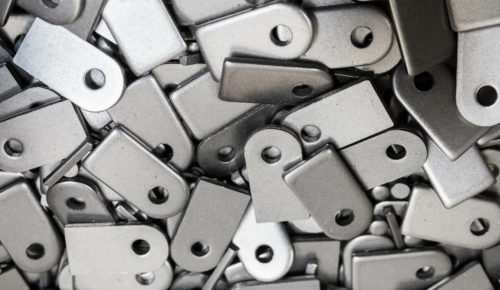Comprehensive Overview to Metal Stamping: Methods, Applications, and Benefits
Comprehensive Overview to Metal Stamping: Methods, Applications, and Benefits
Blog Article
Exploring the World of Metal Stamping: From Style to Manufacturing
Within the world of manufacturing, metal marking sticks out as an exact and effective approach for forming steel sheets right into numerous kinds with remarkable consistency. From the initial design phase where intricate patterns take form to the detailed manufacturing procedures, steel marking is a mix of virtuosity and design. Looking into this world introduces a complex interplay of imagination and technological mastery, using a look into a realm where advancement satisfies craftsmanship.
History of Metal Stamping
Steel marking, a commonly utilized manufacturing procedure today, has a rich history that dates back to old times (Metal Stamping). The beginnings of steel stamping can be traced to old human beings such as the Egyptians, who utilized stamping methods to embellish precious jewelry and accessories with elaborate designs. Over time, steel stamping developed, with civilizations like the Greeks and Romans using it for producing coins and ornamental items

In the 20th century, metal marking remained to advance with the combination of automation and computer system numerical control (CNC) modern technology. These improvements further raised the effectiveness and accuracy of metal marking processes, making it an indispensable component of modern-day manufacturing throughout sectors such as automotive, aerospace, and electronics. Today, steel stamping continues to be an important production procedure, integrating practice with development to satisfy the needs of a continuously advancing industry.
Style Factors To Consider and Prototyping
When developing metal marking jobs, thorough attention to make considerations and prototyping is essential for ensuring optimum manufacturing end results. Layout considerations in steel marking consist of material choice, part geometry, tooling design, and production usefulness. Selecting the ideal product is important as it impacts the component's efficiency, price, and manufacturability. Part geometry influences the complexity of the stamping procedure and the performance of the end product. Tooling style plays a significant duty in the success of steel stamping projects, impacting part precision, device longevity, and manufacturing efficiency.
Prototyping is a vital phase in the steel stamping process that allows designers to test the layout, validate manufacturability, and make required modifications prior to full-blown manufacturing. Prototyping aids recognize possible problems beforehand, saving time and prices in the future. It likewise supplies a possibility to optimize the style for efficiency and quality. By carefully thinking about style aspects and utilizing prototyping, producers can improve the metal look at this now stamping procedure and achieve top quality, economical manufacturing end results.
Tooling and Devices Fundamentals
Taking into consideration the essential role that tooling layout plays in the success of metal stamping jobs, recognizing the necessary tools and devices needed is vital for achieving efficient production outcomes. Tooling is a basic aspect of steel stamping, as it straight influences the quality and uniformity of the final products. Crucial tools consist of passes away, strikes, and components, which are custom-designed to shape and form the steel into the preferred parts. Dies are the main tool made use of to reduce and form the steel, while strikes help create holes or particular shapes. Components hold the steel in area throughout the marking procedure, making certain accuracy and repeatability. In addition, tools such as stamping presses, feeders, and coil handling systems are essential for automating the stamping procedure and raising performance. Investing in high-quality tooling and devices not only improves manufacturing efficiency yet likewise causes higher accuracy, reduced waste, and overall cost financial savings in steel stamping operations.
Production Process and Quality Control
Successfully handling the manufacturing process and applying durable high quality control procedures are necessary for guaranteeing the success of metal stamping tasks. The production procedure in steel stamping entails a collection of steps that need to be thoroughly coordinated to achieve ideal results. It starts with the prep work of resources, followed by the setup of the marking tools and tooling. Operators then feed the products into journalism, where the marking operation takes location. Throughout this process, it is important to check the assembly line for any issues that might affect the quality of the stamped components.
Quality control in metal marking is critical check over here to provide products that meet the needed requirements. Examining the stamped components at numerous stages of production aids determine any type of issues early on, preventing costly rework or scrap. Methods click over here such as dimensional inspection, visual assessment, and product testing are commonly employed to make certain the quality of the stamped components. By preserving strict quality assurance requirements, producers can promote their reputation for delivering high-quality metal stamped products.
Applications and Industry Insights
In the realm of steel stamping, the effective application of production procedures and high quality control steps directly affects the effectiveness and dependability of numerous sector applications and provides important understandings right into the market's functional dynamics. Metal marking finds prevalent application across diverse markets, consisting of automobile, aerospace, electronic devices, and appliances. In the automotive field, metal marking plays an essential role in creating components such as chassis, braces, and structural get rid of high precision and efficiency. The aerospace market relies upon steel stamping for manufacturing detailed parts like panels, brackets, and fittings that fulfill rigid high quality criteria (Metal Stamping). In the electronics market, steel marking is utilized to create precise elements like adapters, terminals, and warmth sinks. Furthermore, metal stamping facilitates the manufacturing of numerous home home appliances, including refrigerators, cleaning devices, and stoves, by giving affordable solutions for producing long lasting and complicated components. Recognizing the applications and market understandings of steel marking is important for enhancing manufacturing procedures and improving item top quality throughout various fields.

Conclusion
Layout considerations, prototyping, tooling, tools, production procedures, and high quality control are important facets of metal stamping. With its widespread applications and market understandings, steel stamping proceeds to be a versatile and reliable manufacturing process.
Report this page